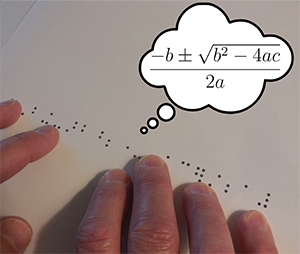
Math that feels good


Mathematics and science Braille textbooks are expensive and require an enormous effort to produce — until now. A team of researchers has developed a method for easily creating textbooks in Braille, with an initial focus on math textbooks. The new process is made possible by a new authoring system which serves as a “universal translator” for textbook formats, combined with enhancements to the standard method for putting mathematics in a Web page. Basing the new work on established systems will ensure that the production of Braille textbooks will become easy, inexpensive, and widespread.
“This project is about equity and equal access to knowledge,” said Martha Siegel, a Professor Emerita from Towson University in Maryland. Siegel met a blind student who needed a statistics textbook for a required course. The book was ordered but took six months (and several thousand dollars) to prepare, causing the student significant delay in her studies. Siegel and Al Maneki, a retired NSA mathematician serving as senior STEM advisor to the National Federation of the Blind, and who is blind himself, decided to do something about it.
The collaboration which solved the problem was formed in January, 2019, with the help of the American Institute of Mathematics, through its connections in the math research and math education communities.
There are three main problems to solve when producing a Braille version of a textbook. First is the overall structure. A typical textbook uses visual clues to indicate chapters, sections, captions, and other landmarks. In Braille all the letters are the same size and shape, so these structural elements are described with special symbols. The other key issues are accurately conveying complicated mathematics formulas, and providing a non-visual way to represent graphs and diagrams.
This work is part of a growing effort to create high-quality free textbooks. Many of the textbooks authored with PreTeXt are available at no cost in highly interactive online versions, in addition to traditional PDF and printed versions. Having Braille as an additional format, produced automatically, will make these inexpensive textbooks also available to blind students.
More details are available on the AIM website .